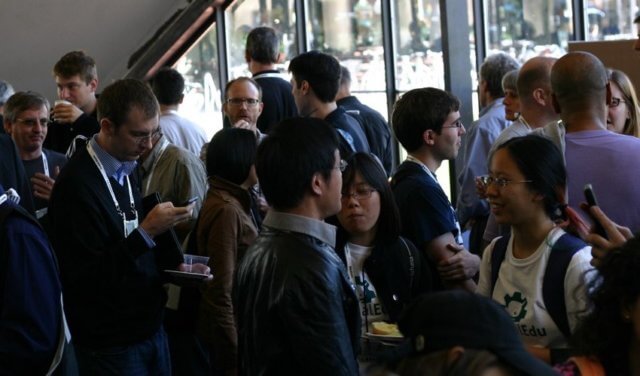
Wouldn’t it be great if we could improve the quantity and quality of hallway learning, conversations, and connections throughout an event?
Well, we can. Here are two ways.
1—How to improve conventional hallway conversations
We can increase the quality of conventional hallway conversations by designing a physical meeting environment that encourages and supports them. Create an architecture of assembly: spaces outside the session rooms where people can talk comfortably. Provide a range of spaces. For example, chair pairings, small group furniture arrangements, standing areas with places to park food and beverage, covered outdoor spaces, etc.
“…people, even very smart people, are unable to anticipate the benefits of in-depth interaction with colleagues until they have experienced it for themselves”
—Nancy Dixon, The Hallways of Learning
Read Nancy’s article to learn how an office redesign strengthened connections amongst a group of formerly loosely connected peers. [And she gets a hat tip for inspiring this post!] Similarly, your design layout will affect the likelihood and value of hallway learning conversations. And participants most likely won’t even be aware of it!
In addition, be sure to schedule enough time for hallway learning to occur. Give your attendees plenty of breaks. Then they can rest and recuperate, consolidate what they have learned, and have time to engage in conversations that matter.
2—How to significantly improve hallway learning and connection throughout events
By far the best way to significantly improve hallway learning and connection is to build it into our meeting sessions.
Why should we do this? Here’s Nancy again:
“Typically, a presenter offers what happened in his or her own situation, but that is not what learners need to hear. Learners are interested in knowing how to adapt the lessons to their situation and for that they need to have a conversation so that the other person can understand their context, and they also can understand the context of the other.”
The trick is to use session designs that blend short useful pieces of content with conversations among participants. In effect, you’re providing structured hallway conversations about the content that’s just been delivered. There are many different formats you can use for such conversations (described in detail in my books): pair and trio share, facilitated small group breakouts, fishbowls, etc. You can create conversational groupings at random (“pair up with someone you haven’t met yet”) or use human spectrograms to assign attendees to like-minded folks.
Building hallway learning opportunities into our meeting sessions has additional advantages. Once a session is over, and traditional hallway conversations are about to begin, attendees are ready to continue or start new conversations with the people who were in their session. They are primed to continue to explore and deepen their hallway learning.
Conclusion
I’ll close with a final Nancy Dixon quote from a different post:
“Before people can learn from each other or collaborate on issues, they need to build connections – that is, gain some understanding of who the other person is, including their skills, depth of knowledge, experience, and attitude toward others. People are unlikely to ask each other questions or ask for assistance, until they have built a connection that allows them to learn that the other person is knowledgeable enough and respectful enough to engage.”
—Nancy Dixon, Connection before Content
To maximize useful connection and learning at our meetings, optimizing hallway learning throughout the event is the way to go!
[Cropped] image attribution Wikimedia Commons under Creative Commons license Attribution-ShareAlike 2.0 Generic (CC BY-SA 2.0)

Smiling. First, the (stock?) photo gave me schpilkes! Too crowded and certainly now and even more when I and others like me a) use mobility devices and b) want to be able to hear well enough.
Then: too many people don’t know that Harrison Owen, around 1985, coined the term “Open Space Technology” as a result of observing where some of the best learning happened – in hallways, at breaks, and for women, in restroom lines (because the waits are so long!) https://openspaceworld.org/wp2/what-is/
When I wrote my first column for Meeting News in 1994 under the heading “The Best Laid Plans …”, I wrote about the timing for breaks – that we gave far too little for people to do just this, Adrian – to ask the speaker questions unasked, gather our stuff, take a bio-break, AND have the ever-important hallway conversations. 15 Minutes was the ‘rule’; still today, even a half-hour is not enough because we crowd content. For those who must get CEs, rushing to another session means that processing with others what they learned is lost.
You know this. I know this. Too few still practice it. What will make it change?
Thanks!
Joan, I thought I knew a fair amount of Yiddish, but “shpilkes” is a new one for me :).
Obviously, we agree: conventional meeting breaks are almost always too short. Unfortunately, it’s hard to convince stakeholders to lengthen them. That’s one of the reasons you and I build conversation, connection, and participant-driven learning into the meeting sessions themselves. This introduces these vital activities, increases the time for participation in them, and paves the way for them to continue in the breaks.
Smiling – it’s such a wonderful word and it’s like “flopsweats” and so descriptive.
It’s all stakeholders including venues – that proscribe the use of space and time and even F&B at breaks. (IF IACC conference centres did what they used to – continuous breaks or if they do again when COVID is settled down) and we had continuous breaks, they too would contribute to the ability to refresh and converse.
I would like organizations to have a fee to attend that doesn’t include going to sessions or meals or why-bother-networking-because-they’re-too-loud receptions and just to ‘be’ there to have all hallway learning. And with so many ways to earn CEs for all professions, it can move in that direction. Why do we have these conversations and I have had them for 50 years and it just doesn’t change?